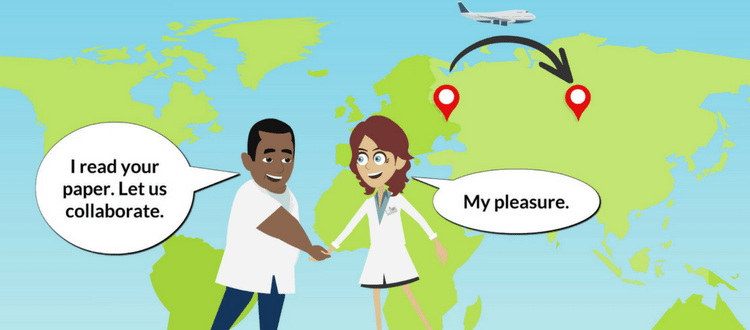How Collaborations Increase Research Impact

Good science is never conducted in vacuum. Scientific collaboration is a large part of successful research, and without collaboration, scientists can miss out on good ideas. Mobile scientists, who move between countries over the course of their research, are instrumental to this collaboration. Recent social and political movements, such as Brexit and the United States travel ban, have the potential to threaten scientific collaboration. These movements lower the ability of scientists to travel, which can keep reputable research and good ideas from spreading.
The Effects of Collaboration
Scientists need not be mobile to collaborate effectively, but mobile scientists’ work has a greater impact on the scientific community. This is because their work spreads quickly to diverse corners of the world, attracting interested scientists with varied perspectives. In recent months, multiple studies proved that scientists’ mobility is correlated with the amount of collaboration they participate in. This increased amount of collaboration is also correlated with scientific impact.
Mobile scientists often publish research through institutions in countries other than their own. Although this increases visibility of their work, increased impact is not a measure of quality. Cassidy Sugimoto, a professor at Indiana University, showed that visibility can be positive or negative. She and her colleagues, including Nicolas Robinson-Garcia of the Technical University of Valencia, have observed a feedback loop benefitting veteran scientists. This loop, called the Matthew Effect, helps visible scientists become mobile, increasing visibility further. Newer scientists may experience difficulty promoting their work when this loop exists.
Increased visibility encouraged scientists to move between countries. This can affect different nations in different ways. Some brain drain has been observed in recent years in Asia, while diversity of research and scientific innovation has been increasing in developed countries. Many women from Middle Eastern countries experience a jump in their production and impact when they come to the United States. North America and Europe attract scientists from all over the world, and also export accomplished scientists into new networks across the globe.
Recent Travel Restrictions Affecting Scientists
When “Brexit” signaled that Britain would leave the European Union, the implications of the vote were of concern to scientists. Brexit is already affecting research collaborations across Europe in a negative way. British scientists fear being cut off from European scientific networks that they rely on for funding and collaboration. Tentative plans are in place to ensure scientists will not lose opportunities. However, the scientists are still uncertain of their future until the second stage of Brexit talks.
A similar situation is occurring in the United States, where President Donald Trump’s travel ban prohibits citizens of multiple countries from entering. The ban has blocked scientists from short-term travel to the USA, and made it more difficult to attend meetings. The impact is especially severe for Iranian scientists, whether students or established researchers. A number of talks have been canceled in several fields, right from geology to genetics. Legal challenges may lessen these restrictions in the future, as they have in previous versions of the ban.
The motivations behind these policies which limit scientific collaboration are varied, and reflect the current social and political climate of each country. Some attribute the restrictive policies to a rise in nationalism or populism. On the other hand, some see them as a reflection of fears about immigration and global interconnectivity. Some researchers also interpret the measures as an expression of distrust toward science in general. The multifaceted nature of these motivations makes finding a solution that will please all parties particularly difficult.
Openness and Scientific Impact
Caroline Wagner, a social scientist at Ohio State University, has studied how a country’s openness to scientific collaboration and diversity affects its scientific productivity and impact. She and her colleagues analyzed a variety of factors. These included how easily researchers can enter or exit a country and the impact of gender or racial diversity. Wagner’s work echoed Sugimoto, highlighting a correlation between ability to move and scientific impact. The ability to move contributed to greater diversity and innovation in laboratories.
Wagner’s work shows that a country’s openness is a powerful predictor of how much impactful science it produces. Although investment in research and development is important, openness was a better predictor of how well a country’s scientific knowledge would spread, and how enticing it would be to those with new ideas. Some countries are embracing Wagner’s work and making a concerted effort to increase diversity and collaboration. According to scientists studying the phenomenon, these countries may soon challenge the current global scientific powerhouses.
A lack of global openness to scientific collaboration could have far-reaching impacts, affecting many people inside and outside the scientific community. Male scientists are generally more mobile than female scientists, and restrictions to mobility could widen that divide. Local scientific networks would not progress without international cooperation, impacting the daily lives of scientists and non-scientists alike. Without new ideas, innovation could stall, slowing progress globally in the scientific community.
Maintaining the Progress of Science
Sugimoto, Wagner, and their colleagues believe that governments must take steps to promote easier travel between countries for the sake of science. This is not an easy undertaking, since the Matthew Effect and other potential biases exist. Sharing the benefits of science makes it the most useful to the global community. Collaboration among scientists all across the world ensures this.
The preservation of scientific progress is a long-term goal which requires constant maintenance. Short-term goals serving the interests of individual countries are also important, but they conflict with scientific progress when they restrict collaboration. Advocates for greater scientific collaboration believe that countries should rely on long-term objective data trends concerning diversity and impact to make effective policies.
Scientific collaboration is essential on both the international and local levels. Wagner pointed out in her work that a single policy may not be useful for all collaboration levels. Creating robust policies that can enrich scientific collaboration at both the local and international level may prevent the stall of progress.
What are your views on promoting scientific collaboration through travel? Please share your thoughts with us in the comments section below.









